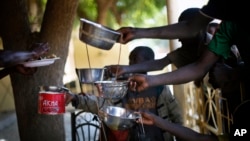At a food distribution station in Bamako, Salimatou Maiga offers advice to the other women in line, advising them to add sugar and milk to the powdered porridge mix to improve the taste for their hungry children.
The West African nation's ongoing conflict, combined with the country’s lean season, is once again threatening to aggravate a food-scarcity situation for those still recovering from a brutal Islamist occupation.
The World Food Program says more than 1.5 million people are currently food insecure in Mali’s north; one in five households in the three northern regions of Gao, Kidal and Timbuktu face extreme food shortages.
During the lean season, June through October, some 1.9 million people — 40 percent of northern Mali's population — will have trouble finding their next meal.
“It’s only about 700,000 people who have received food assistance according to [the United Nations Office for the Coordination of Humanitarian Affairs]," said Erin Weir, protection and advocacy advisor with the Norwegian Refugee Council (NRC),adding that people are still suffering and the crisis is far from over.
"If you consider that 1.5 million people are in urgent need and the number is over 3.6 million overall who have some level of food insecurity, the fraction of people who have been helped compared to the number in need is huge. There’s a massive gap there," he said. "We know that food insecurity also prompts displacement. People who are [otherwise] not inclined to leave will [do so] to find food and water ... the absolute basic needs of life, and currently we are not able to fulfill those.”
Ongoing violence, displacement
Despite international military intervention and an election to restore a working government, violence is continues in the north, triggering news rounds of mass displacement. In May, thousands of people in the Kidal region were forced to flee following clashes between rebels and government troops.
To the south in Bandiagara, a district in the Mopti region hit hard by food scarcity, people have been forced to cut meals and sell items to survive.
Last year, rains failed in many areas across Mali, while this year the rains, usually at their heaviest between June and September, arrived late.
In the Timbuktu and Kidal regions, herders have warned that insufficient rains are making it difficult to find suitable pastures to sustain their livestock. Animals that used to sell for $500 are now in the market for a tenth of the price, according to one local non-governmental organization, and attacks on aid workers and supply trucks have disrupted food transport.
The International Committee of the Red Cross (ICRC) halted food distribution outside the northern towns of Gao, Kidal and Timbuktu following the attack and kidnapping of four of the organization’s staff members earlier this year.
According to Abdi Mohamed Dirieh, a Bamako-based ICRC official, the decision to halt aid shipments in May has left those fleeing recent violence with little or no assistance, and that although the organization has been slowly scaling up operations, things are not yet back to where they need to be.
While many of the displaced from northern Mali have gradually been returning since the ouster of Islamist insurgents in early 2013, many are still worried about their safety, says Weir of the NRC.
"Some people returning home ... don’t feel comfortable going back to their communities," he said. "Concerns about retributions and perceptions of who they are and who they might have been affiliated with during the conflict are an issue of concern. As power shifts in different areas, different allegiances means that certain people might feel secure one minute and not the next and, again, that’s why we see new displacements when power shifts.”
While the situation in the north remains difficult, life in Bamako is expensive, and many northerners have no choice but to return home says Weir.
But in Gao, people like Salimatou Maiga can only hope for peace to return soon.






